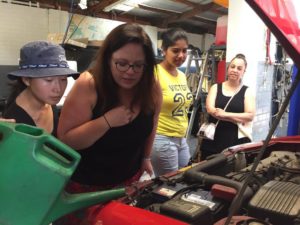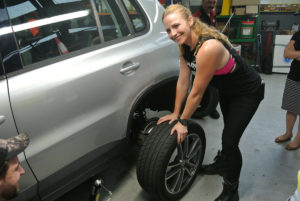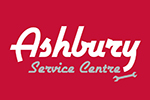The Fast and the Fabulous Ashbury Drift
Confession time. I don’t know much about my car.
If there is a flashing light on the dashboard, I’d be more likely to ask my Dad than know what to do about it. If I got a flat tyre I’d be calling Roadside Assist faster than a P-plate driver on their maiden journey down the freeway.
That is.. until I did the Ladies Car Course at the Ashbury Service Centre.
Nicole designed the course to help women:
- Feel more confident with their cars
- Learn the 10-minute-a-month maintenance basics that can protect a car
- Be equipped with a few key questions which can show their mechanics that she knows a thing or two about cars
There were six of us on the course and Nicole’s dad, Manuel, and her brother, Danny, drove our cars into the bay.

The first question of the day was ‘Do you know how to open the bonnet?’
Some of us were glad for an easy question. Others looked sheepish. The benefit of having all of our cars there was that we learned to identify how to open the bonnet on different types of cars. This is super-helpful because we’re not always going to be driving our own cars, and this course is all about learning, rather than being shown.

Once the bonnet was open we learned how to
- Identify and refill the window washer liquid
- Identify the coolant and top it up with water if the liquid level is low
- Check the oil and identify the oil ‘health’
- Predict whether there are spiders in the car before one jumps out while we’re driving!
- Look for signs of corrosion (and acid leaks) on the car battery
At first we were being delicate, as if we were all protecting fresh manicures. We were standing at respectful distances while observing what to do. By the second or third car we were crowding around the open bonnets, heads well under the lid or jumping into the driver’s and passenger seats to find where the bonnet lever is in each car.
Ever the list-maker, I loved having a list of items to keep in my car for monthly maintenance provided to me after the course. Some of the items were expected, others were used in a more creative sense to avoid running out to the shops.

I park my car on the street, rather than in a garage, and I know that having the supplies to do maintenance means that I am more likely to do it.
The Cardoso family created a great atmosphere of bonding and learning. It was fun, and interactive and we were all proud of what we were learning. Applying our new knowledge, one car at a time, helped us test and deepen our understanding.
Then we learned how to change a tyre.
We were very excited to discover that in each car boot there is (almost) always a:
- Spare ‘road’ tyre – these tend to be much smaller and lighter than a regular tyre and are designed to get you only as far as the nearest tyre store
- Jack – for lifting the car off the ground a little so the tyre is off the ground
- Wheel brace – for loosening and tightening the wheel nuts
There should also be a safety kit which includes:
- Wheel chocks to stop the car rolling back
- A reflective road-safety triangle sign to put about 10 metres in front of your car
- A hi-visibility vest, which is absolutely essential. If you need to replace your tyre on a freeway you want to make sure that cars approaching you at 110km per hour have their best chance of seeing you.
If you don’t already have one of these kits, you can purchase a ‘St John Car Safety First Aid Kit’ which includes these items plus a small amount of first aid supplies.
Changing a tyre can seem intimidating, but it’s actually really simple.
 Anyone can do it, no matter their size or strength. Loosening the wheel nuts and lifting the blown tyre and the replacement tyre looked like child’s play for the tall girl who did cross-fit. But was also something that one of the students who was much smaller and lighter could also do. It may take a while – 20 or 30 minutes, but it’s still faster than having to wait for roadside assist. It’s also really fun to be able to do something you thought wasn’t possible!
Anyone can do it, no matter their size or strength. Loosening the wheel nuts and lifting the blown tyre and the replacement tyre looked like child’s play for the tall girl who did cross-fit. But was also something that one of the students who was much smaller and lighter could also do. It may take a while – 20 or 30 minutes, but it’s still faster than having to wait for roadside assist. It’s also really fun to be able to do something you thought wasn’t possible!
It’s really important to have shoes with a fairly thick sole when you’re driving (Converse sneakers would be fine). It makes it easier to put pressure on the wheel brace to loosen the wheel nuts. Sneakers mean you can put equal pressure on the pedals, which can have insurance implications. I am guilty of wearing Havaiana flip flops while driving, or even driving barefoot. Since doing the course I keep a pair of cheap sneakers in my car and slip them on before I set off driving anywhere.
Worried you’ll forget it all?
Within a few days of the course I received an email with the summary of all that was discussed including questions that you can ask your mechanic to keep them on their toes. It was good to not worry about taking notes but taking the time to ask all the questions you’ve ever had knowing the answer will be un-biased and technically correct from a qualified professional. Then there is also the reminder to book the e-Safety check free of charge included as bonus of attending the course.
It was great having the run of the garage. Everyone moved carefully around the equipment and were in really great hands with the Cardoso siblings. It helped me break down barriers between myself and the mechanic’s workspace, which I think will help me be more confident in asking questions about the work being done on my car.
Courses for women, in traditionally male fields, can be branded bright pink and sparkly. I find that type of marketing patronising. Ashbury Service Centre focuses more on family and learning than getting caught up on gender. While this course is called the ‘Ladies Car Care Course’ I think it’s a course that could be enjoyed by anyone. It’s also an entertaining and informative (and different) way to spend an afternoon with your girlfriends or sisters, aunt, mum and even grandma.
What you learn could save you money, time, prolong the life of your car and maybe even save a life.
Blog post by Rachel Alt
